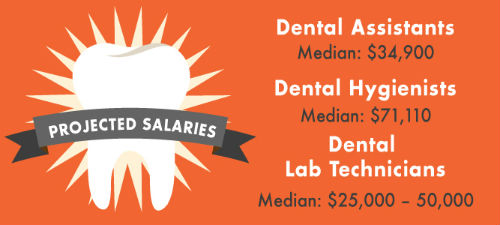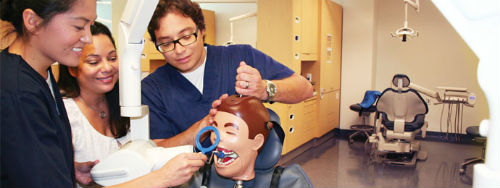

If you’re not yet in the dental field, the terms dental assistant and dental hygienist may seem like the same thing. They are, however, two separate jobs. While they both support licensed dentists, the day-to-day duties and training required for each can be very different. Here’s a breakdown of the main differences between dental assistants and dental hygienists so you can decide which is the right career path for you.
One of the main differences between dental hygienists and dental assistants is the amount of training and licensing required for the position.
To become a dental hygienist, you need to have a minimum of an associate’s degree in dental hygiene, although there are bachelor’s degree programs as well. Most associate programs take three years to complete and include laboratory, clinical, and classroom instruction on anatomy, physiology, pharmacology, nutrition, radiology, dental equipment, and microbiology. Because hygienists work closely with patients, behavioral science training may also be included. To prepare for an accredited dental hygiene program, you should take math, biology, and chemistry classes in high school or at a community college.
Once you graduate, you’ll also need to pass written and clinical exams in the state in which you wish to work. Exams vary from state-to-state, so make sure the California dental hygienist school you choose will prepare you for them. The written exam administered by The American Dental Association’s (ADA) Joint Commission on National Dental Examinations satisfies the written exam qualification for all 50 states, but not the District of Columbia. If you graduate from a program outside of California, but plan to work in California, your clinical exam may have special requirements in order for you to pass.
The requirements for becoming a dental assistant are fewer. In fact, some states require no formal education or training at all. The dentist who hires you will simply train you him- or herself. California does not require a certificate or training program, but Claudia Pohl, former president of the American Dental Assistant Association and a veteran in the field with more than 35 years of experience, recommends getting one. Dental assistant jobs are in high demand, and getting formal education in your field will help you beat the competition. Plus, registered dental assistants tend to make more money and can perform more tasks than those without a certificate.
Dental assistant programs include lab work and classroom learning for dental assisting skills and theory. You’ll need a high school diploma to get into most programs, and taking chemistry, biology, and office management classes will also help.
One of the biggest differences between dental assistants and dental hygienists is what their daily activities look like. Overall, a hygienist has much more responsibility, freedom, and unsupervised time with patients throughout the day.
A dental assistant’s duties may include:
Registered dental assistants may also perform the following tasks:
A dental hygienist’s duties may include some of a dental assistant’s duties, such as creating molds and taking x-rays. For the most part, however, a hygienist’s additional training means he or she will most likely spend the day without direct supervision from the dentist. Instead, they are empowered to do much of the following on their own:
Depending on state in which you obtain your dental hygiene certification, you may also be able to do other duties, such as periodontal therapy such as root planning or deep cleaning to remove infected root structures. The state of California in particular permits registered dental hygienists to administer local anesthetics, oxygen, and nitrous oxide, for example. These skills are taught at all 28 of the accredited dental hygiene schools in California.

So what is it actually like to have one of these jobs in the dental industry? Overall, jobs in dentistry are highly sought-after. They are stable careers where you can help people every single day without a lot of stress or working a lot of hours.
Dental Assistant jobs don’t require much schooling, but pay a median annual salary of just $35,390. and Money-U.S. News & Worlds Report ranks dental assistants #17 in Best Health Care Support Job and #72 in The 100 Best Jobs overall category.
Dental Hygiene jobs require more schooling and responsibility, but pay an average of $71,520 per year and are known for offering a great work-life balance, a strong future for growth, and low stress. Money-U.S. News & Worlds Report voted it 2nd Best Health Care Support Job and it’s in the top third of "100 best jobs" in America.
Dental assistant and Dental hygiene jobs are both in high demand. The Bureau of Labor Statistics (BLS) expects these jobs to grow by up to 18 percent by 2014, which is much considerably more than most jobs. The reasons are that people are learning to take better care of their teeth and visit the dentist more often. This uptick in visits by patients also means a higher dental hygienist salary.
Ask yourself whether you’d like to work closely with a dentist, or prefer to work more independently. While dental hygiene schools in California can be more expensive and take longer to complete, the difference in salary can be well-worth it. Plus, with available scholarships and student financial aid, the right program might be cheaper than you think. At California's Community Colleges, dental hygiene programs are very competitive. Cabrillo College dental hygiene program, for example, can run under $20,000 for ALL classes, training, and equipment. On the other end of the educational spectrum, the USC dental hygiene Program is well above 100k!!